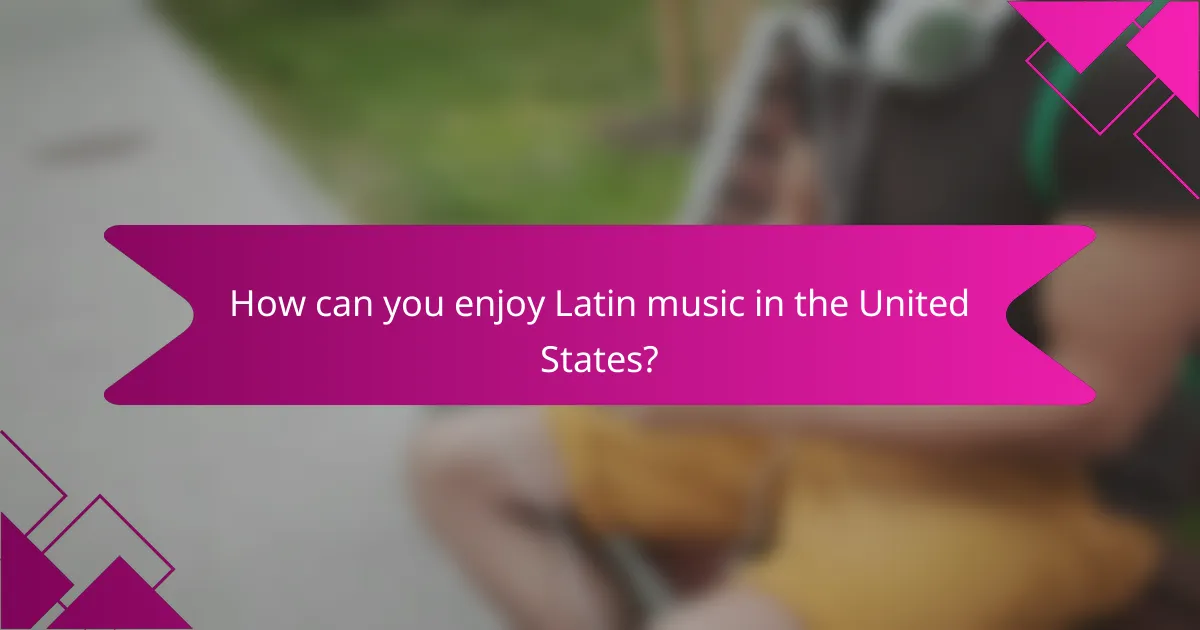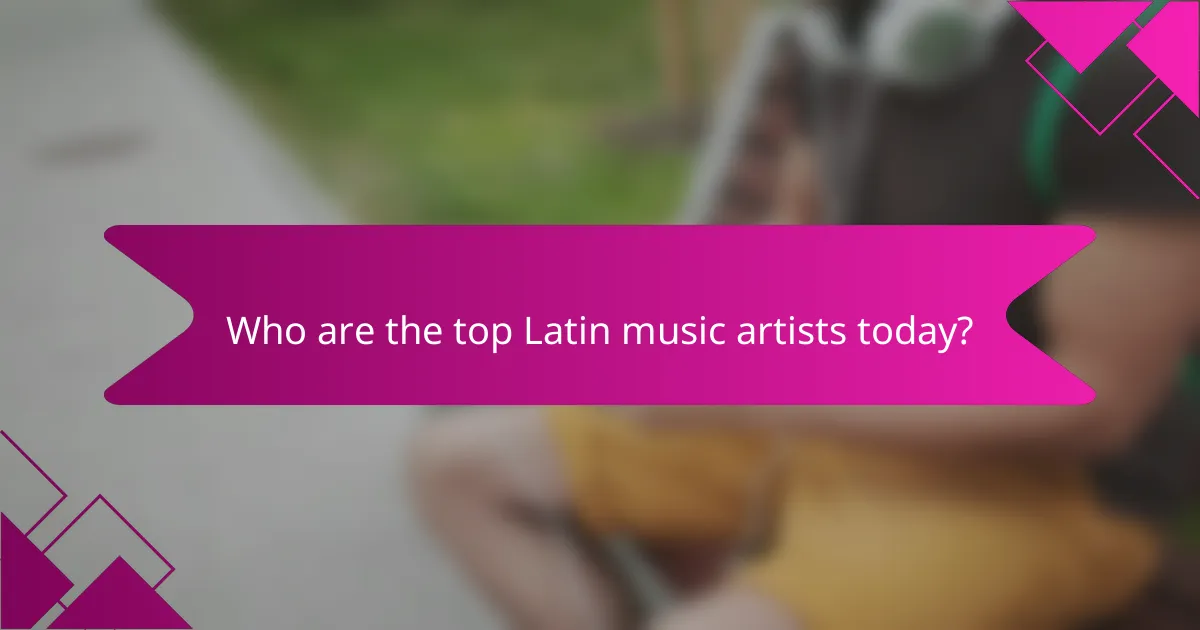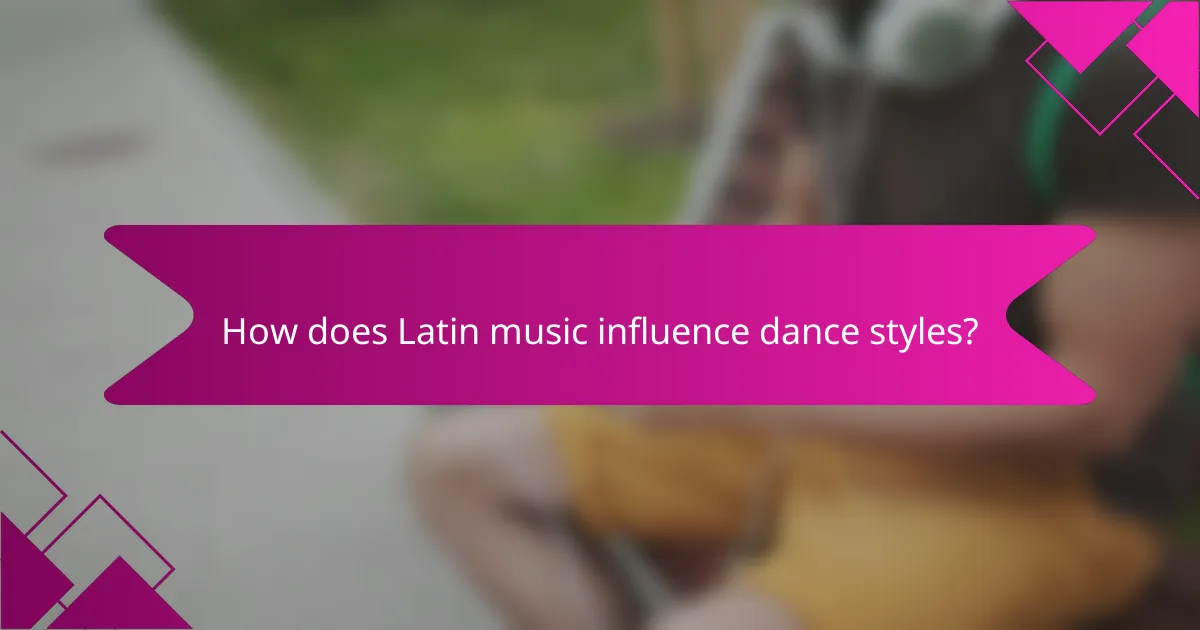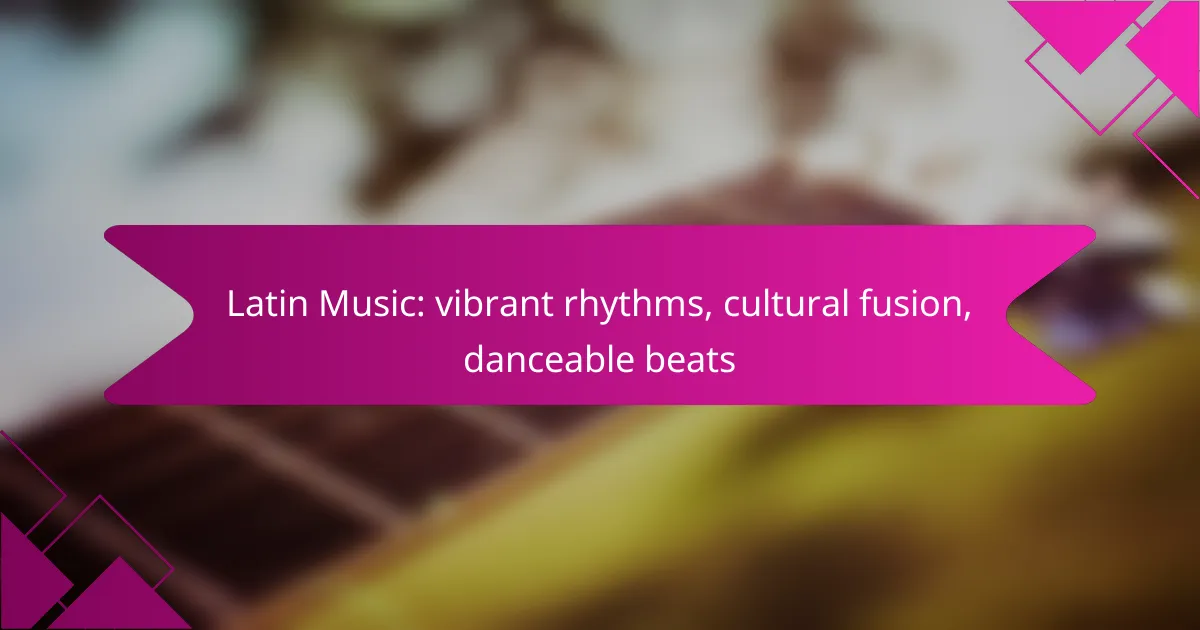Latin music is a dynamic genre characterized by its vibrant rhythms and cultural fusion, making it a favorite for dance enthusiasts around the world. With genres like Salsa, Bachata, and Reggaeton, it offers a rich tapestry of sounds that reflect diverse influences. Today’s top artists, such as Bad Bunny and Shakira, continue to innovate and captivate audiences, ensuring that Latin music remains a powerful force in the global music scene.

How can you enjoy Latin music in the United States?
Enjoying Latin music in the United States is easy and accessible through various platforms and events. From streaming services to local festivals and dance classes, there are numerous ways to immerse yourself in the vibrant rhythms and cultural fusion that characterize this genre.
Streaming platforms like Spotify
Streaming platforms like Spotify offer extensive libraries of Latin music, making it simple to discover new artists and genres. You can explore curated playlists that feature everything from salsa to reggaeton, allowing you to find the perfect soundtrack for any occasion.
To enhance your experience, consider creating your own playlists or following artists to receive updates on new releases. Many platforms also provide personalized recommendations based on your listening habits, helping you dive deeper into the Latin music scene.
Latin music festivals across the country
Latin music festivals take place throughout the United States, celebrating the rich diversity of Latin culture. Events like the Coachella Valley Music and Arts Festival in California and the New York Latin Music Festival showcase a variety of artists and styles, attracting thousands of fans each year.
Attending these festivals not only allows you to enjoy live performances but also provides opportunities to experience food, art, and dance from different Latin cultures. Check local listings for dates and lineups to plan your visit accordingly.
Local dance classes in major cities
Many major cities in the U.S. offer local dance classes focused on Latin styles such as salsa, bachata, and merengue. These classes cater to all skill levels, making it easy for anyone to join in and learn the steps to these energetic dances.
Look for studios or community centers that offer drop-in classes or workshops. Participating in these classes not only enhances your dancing skills but also connects you with others who share a passion for Latin music and culture.
Online music courses
Online music courses provide an excellent way to learn about Latin music theory, history, and instrumentation from the comfort of your home. Platforms like Udemy and Coursera offer courses that cover various aspects of Latin music, including rhythm patterns and song structure.
These courses often include video lessons, quizzes, and community forums, allowing you to engage with instructors and fellow students. This flexibility makes it easier to fit learning into your schedule while deepening your appreciation for the genre.
Latin music radio stations
Listening to Latin music radio stations is a great way to stay connected to the latest hits and classic favorites. Many cities have dedicated Latin music stations, while online platforms like Pandora and iHeartRadio offer genre-specific channels that play a mix of popular tracks.
Tuning in to these stations can introduce you to new artists and songs that you may not encounter on mainstream radio. Consider setting up a playlist of your favorite tracks from these stations to enjoy anytime.

What are the popular Latin music genres?
Popular Latin music genres include Salsa, Bachata, Reggaeton, Mariachi, and Cumbia. Each genre has distinct rhythms and cultural influences, making them unique and widely celebrated across the globe.
Salsa
Salsa is a lively genre that originated in the Caribbean, blending elements of Afro-Cuban music with jazz and other Latin styles. Characterized by its vibrant rhythms and fast-paced beats, Salsa is often accompanied by energetic dance. Key instruments include the trumpet, trombone, and various percussion instruments like congas and timbales.
When dancing Salsa, couples typically perform intricate footwork and spins, making it a popular choice for social dance events. Beginners should focus on mastering basic steps before attempting more complex moves.
Bachata
Bachata is a romantic genre that originated in the Dominican Republic, known for its smooth melodies and heartfelt lyrics. It features guitar, bongo drums, and maracas, creating a distinct sound that is both melodic and rhythmic. The dance style is characterized by close partner connection and simple side-to-side movements.
For those new to Bachata, starting with basic steps and gradually incorporating turns and body movements can enhance the dancing experience. The genre’s emotional depth makes it a favorite for intimate settings and dance classes.
Reggaeton
Reggaeton emerged in Puerto Rico in the late 1990s, combining Latin rhythms with hip-hop and dancehall influences. It features a distinctive dembow beat, making it highly danceable and popular in clubs worldwide. Artists often rap or sing in Spanish, adding to its cultural appeal.
To enjoy Reggaeton, familiarize yourself with its catchy hooks and rhythmic patterns. It’s a great genre for parties, as the infectious beats encourage movement and celebration.
Mariachi
Mariachi is a traditional Mexican music genre characterized by its use of violins, trumpets, and guitars. Often performed at festive occasions, Mariachi music is known for its lively and expressive melodies. The musicians typically wear traditional charro outfits, adding to the cultural experience.
When attending a Mariachi performance, expect a mix of romantic ballads and upbeat songs that invite audience participation. Familiarizing yourself with popular Mariachi songs can enhance your enjoyment of this vibrant genre.
Cumbia
Cumbia originated in Colombia and has evolved into numerous regional styles across Latin America. It features a simple, repetitive rhythm that makes it easy to dance to, often incorporating instruments like accordion and drums. Cumbia’s infectious beat has made it a staple at celebrations and parties.
For beginners, mastering the basic Cumbia step is essential, as it serves as the foundation for more complex variations. The genre’s adaptability allows for fusion with other styles, making it a versatile choice for diverse musical tastes.

Who are the top Latin music artists today?
Today, the top Latin music artists are known for their innovative sounds and ability to blend various musical styles. Artists like Bad Bunny, Shakira, J Balvin, Marc Anthony, and Karol G have gained international acclaim, influencing the global music scene with their vibrant rhythms and cultural fusion.
Bad Bunny
Bad Bunny is a leading figure in Latin trap and reggaeton, known for his unique voice and eclectic style. His music often incorporates elements from various genres, making it appealing to a wide audience. With numerous chart-topping hits and collaborations with global artists, he has redefined the landscape of Latin music.
His albums frequently debut at the top of the Billboard charts, showcasing his popularity and the growing influence of Latin music worldwide. Bad Bunny’s energetic performances and relatable lyrics resonate with fans, solidifying his status as a cultural icon.
Shakira
Shakira is a global superstar celebrated for her distinctive voice and dance moves. She blends Latin pop with rock and world music, creating hits that cross cultural boundaries. Her ability to sing in both Spanish and English has expanded her reach, making her one of the most recognized Latin artists globally.
With multiple Grammy Awards and a dedicated fan base, Shakira continues to influence the music industry. Her songs often feature catchy hooks and powerful rhythms, making them perfect for dance floors around the world.
J Balvin
J Balvin is a prominent reggaeton artist known for his catchy melodies and vibrant music videos. He has played a significant role in popularizing Latin music in mainstream culture, collaborating with artists across various genres. His innovative approach to music and fashion has made him a trendsetter in the industry.
Balvin’s albums often feature a mix of upbeat tracks and emotional ballads, appealing to a diverse audience. His contributions to the genre have earned him numerous awards and a loyal following, further establishing his place in the Latin music scene.
Marc Anthony
Marc Anthony is a celebrated salsa artist and one of the best-selling tropical salsa artists of all time. His powerful voice and emotive performances have captivated audiences for decades. Anthony’s music often reflects themes of love and passion, resonating deeply with listeners.
In addition to his successful music career, he has also ventured into acting, showcasing his versatility as an entertainer. His ability to connect with fans through heartfelt lyrics and dynamic rhythms has solidified his legacy in Latin music.
Karol G
Karol G is a rising star in the Latin music scene, known for her contributions to reggaeton and urban music. Her empowering lyrics and catchy beats have garnered her a significant following, particularly among younger audiences. She often collaborates with other artists, enhancing her visibility and reach.
Karol G’s music blends traditional Latin sounds with contemporary influences, making her a fresh voice in the industry. Her success is marked by numerous awards and chart-topping singles, reflecting the growing popularity of female artists in Latin music.

How does Latin music influence dance styles?
Latin music significantly shapes various dance styles by providing vibrant rhythms and infectious beats that encourage movement. The cultural fusion inherent in Latin music creates diverse dance forms, each with unique techniques and footwork that reflect their musical roots.
Salsa dancing techniques
Salsa dancing techniques emphasize quick footwork, body movement, and partner connection. Dancers typically use a basic step pattern that involves shifting weight between the feet, often incorporating turns and spins. Mastering the timing and rhythm is crucial, as salsa music often features syncopated beats that require precise coordination.
Common techniques include the cross-body lead, where the leader guides the follower across their body, and various styling options that enhance individual expression. Practicing these techniques with a partner can improve both timing and connection.
Bachata footwork
Bachata footwork is characterized by a simple four-step pattern that includes side-to-side movements and hip action. Dancers often add a tap or a slight lift on the fourth beat, which adds flair to the basic steps. This dance style encourages close partner connection, allowing for intimate and fluid movements.
To enhance your bachata skills, focus on maintaining a relaxed posture and incorporating body isolation techniques. Practicing with different partners can also help you adapt to various styles and improve your overall rhythm.
Reggaeton dance moves
Reggaeton dance moves are energetic and often emphasize sharp, rhythmic body isolations. The dance style incorporates elements from hip-hop, dancehall, and traditional Latin dances, resulting in a dynamic and expressive form. Common moves include the “perreo,” which involves grinding movements, and various footwork patterns that sync with the heavy beats of reggaeton music.
To master reggaeton, focus on your core strength and flexibility, as these are essential for executing the more intricate moves. Joining a reggaeton dance class can provide structured guidance and help you learn the latest trends in this popular dance style.
Impact on ballroom dancing
Latin music has profoundly influenced ballroom dancing by introducing lively rhythms and styles that enhance traditional forms. Dances like the cha-cha, rumba, and samba incorporate Latin music’s vibrant beats, allowing for more expressive and dynamic performances. The incorporation of Latin elements has made ballroom dancing more accessible and appealing to a broader audience.
In ballroom competitions, judges often look for the ability to interpret the music through movement, making the understanding of Latin rhythms essential. Dancers should focus on developing their musicality and connection with their partners to excel in this evolving dance landscape.
